FIGURE 19–1 Ultraviolet light is electromagnetic radiation with a wavelength shorter than that of visible light, but longer than x-rays.
TABLE 19-2 Ultraviolet Light C Terminology
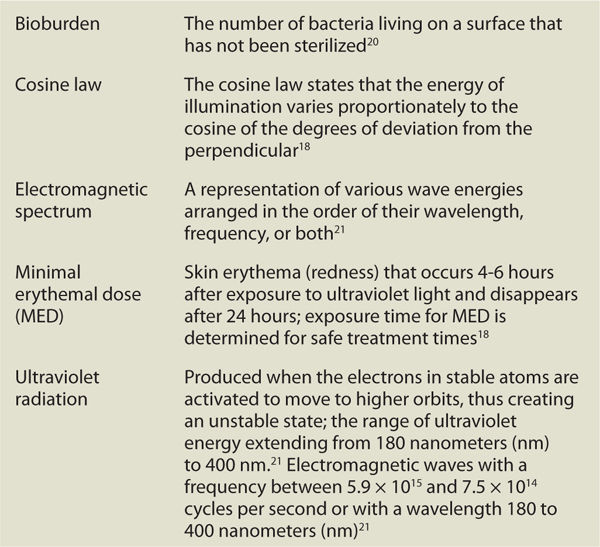
When delivered at therapeutic levels, UVC can be used as an adjunct to antibiotic therapies and topical antimicrobial dressings to decrease the wound bioburden, especially in wounds with inadequate vascular supply that reduces the ability of a systemic antibiotic to reach the infected tissues. When the ultraviolet C device is held 1 inch from the wound bed, the short-wave UVC is delivered at a precise nanometer (254 nm), resulting in a photochemical effect that leads to bacterial cell death.3,6
EFFECTS AT THE CELLULAR AND TISSUE LEVELS
When ultraviolet C is delivered at 254 nm, a photochemical effect occurs in one of the four proteins that make up the double-helix structure of cell DNA in bacteria. Where two thymine proteins are located next to each other on the double helix, the photochemical effect generated by the application of UVC causes the thymine proteins to fuse, thereby altering the DNA in the nucleus of the bacteria and rendering the cell useless. The bacteria cell is unable to metabolize or divide and eventually dies (FIGURE 19-2).4 The inhibiting function of UVC radiation gives this technology the unique ability to kill bacteria without promoting resistance, unlike systemic and topical antibiotics.13 UVC delivered at 254 nm is strongly absorbed by organic molecules, such as the DNA of a bacteria cell, as described above. This same level of UVC light is much too low to have the same negative impact on mammalian keratinocytes and other healthy cells needed for wound healing.5 The ability of UVC to selectively destroy bacteria cells without causing harm to healthy tissue enables the intervention to eradicate bacteria without negatively impacting wound healing.
FIGURE 19–2 UVC alters the molecular structure of the DNA in bacteria and viruses, leading to cell death.
INDICATIONS, PRECAUTIONS, CONTRAINDICATIONS, AND POSSIBLE ADVERSE EVENTS
Ultraviolet C may be indicated in acute or chronic wounds where the presence of bacteria in the wound bed impedes wound healing. Wounds of many different etiologies may benefit from UVC in the presence of bacteria; however, the clinician must carefully consider the various contraindications and precautions to treatment. See TABLE 19-3 for a list of contraindications, precautions, and possible adverse reactions. If a patient experiences an adverse reaction as a result of UVC treatment, the treatment is discontinued immediately.
TABLE 19-3 Ultraviolet C: Contraindications, Precautions, Possible Adverse Effects18
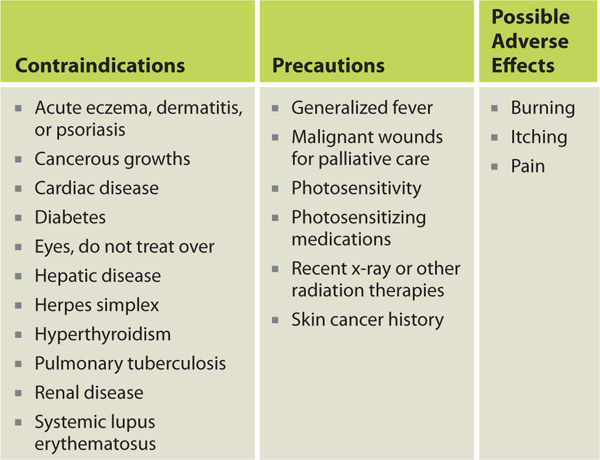
PARAMETERS AND TECHNIQUES FOR APPLICATION
Parameters
Ultraviolet C parameters, when used to decrease wound bioburden, have simplified over the past decade. Prior to 1999, safe treatment times for UV treatment were based on minimal erythema dose (MED).14 However, studies done by Sullivan and Conner-Kerr15,16 and Thai et al.2,3,10 suggest a much shorter UVC treatment time is actually needed to achieve a bactericidal effect than those treatment times determined using the MED method. In addition to time, the other treatment parameter is distance of the UVC source to the wound bed, with a recommended distance of 1 inch or 2.54 cm from the wound surface.10,17 See TABLE 19-4 for UVC treatment parameters. Some UVC devices, like the device seen in FIGURE 19-3 (no longer available through the manufacturer, however, still in use), have a guard built into the unit that can be placed against the periwound skin to ensure the UVC source is delivered 1 inch from and directly parallel to the wound bed, according to the cosine law.18 Newer UVC models, as seen in FIGURE 19-4, do not have a built in guard bar; however, they provide a more compact and portable option.
TABLE 19–4 UVC Treatment Parameters10

FIGURE 19–3 Derma-Wand
FIGURE 19–4 Thera-Wand: Model C-100 Ultraviolet C Treatment Lamp. (Used with permission from Biomation, Almonte, ON, Canada.)
Techniques for Application
Clinical application of UVC requires that both the patient and the clinician wear eye protection, usually with UV protective goggles or with the patient’s eyes draped with a cloth. The UVC equipment should be cleansed prior to and after treatment per the manufacturer’s guidelines. The patient is positioned comfortably to allow maximum exposure of the wound and to ensure that the UVC device is directly parallel and 1 inch from the wound bed. All dressings are removed from the wound prior to treatment as ultraviolet light does not penetrate any dressings, including transparent films.2 After wound cleansing and debridement when indicated, a coat of nontoxic ointment that can block ultraviolet rays to the skin is applied around the wound, avoiding the wound bed itself. Draping cloths over the surrounding skin is also recommended (FIGURE 19-5). Once the patient’s eyes are draped, the clinician’s eyes are protected by goggles, and the skin surrounding the wound is protected, the UVC device is held 1 inch from the wound bed with the guard rails (if available) against the surrounding skin or drape to ensure the device is both the proper distance from and parallel to the wound bed (FIGURE 19-6). The UVC light is applied 30 to 180 s/day for 5 days. This treatment course may be repeated after the initial 5 days of application if there are still clinical signs of infection present.10 After each treatment is complete, the clinician’s and patient’s eye protection are removed. The drape and/or UV protective ointment from the periwound skin are removed and the appropriate dressing is applied to the wound. TABLE 19-5 lists key points to remember during UVC application.
FIGURE 19–5 Drape the wound and apply protective ointment to periwound prior to initiating UVC treatment.
FIGURE 19–6 Hold the UVC light source directly parallel and 1 inch from the wound bed.
TABLE 19-5 Application Techniques for UVC
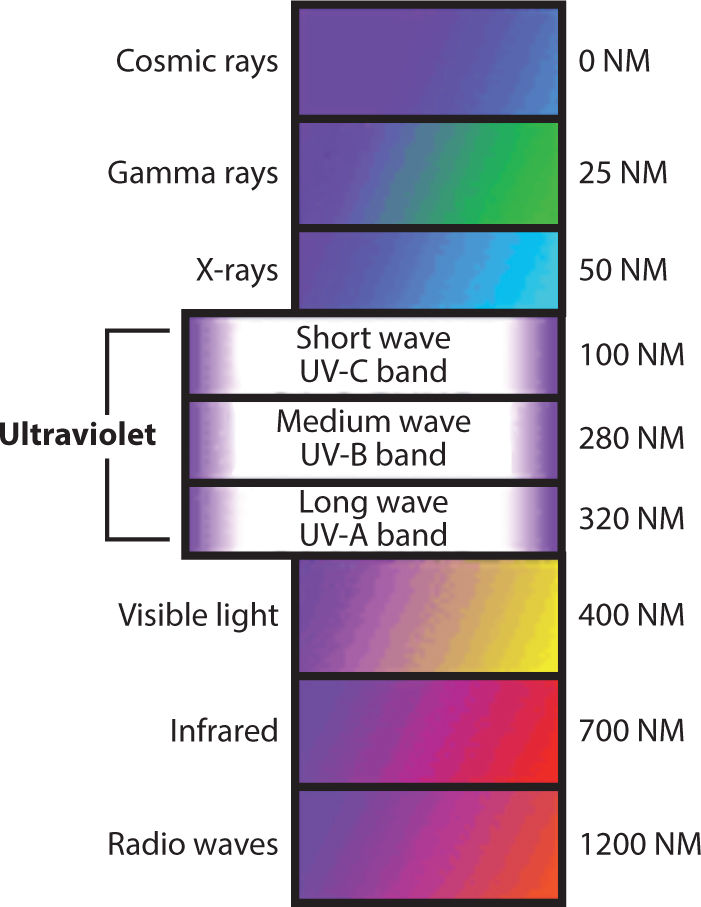
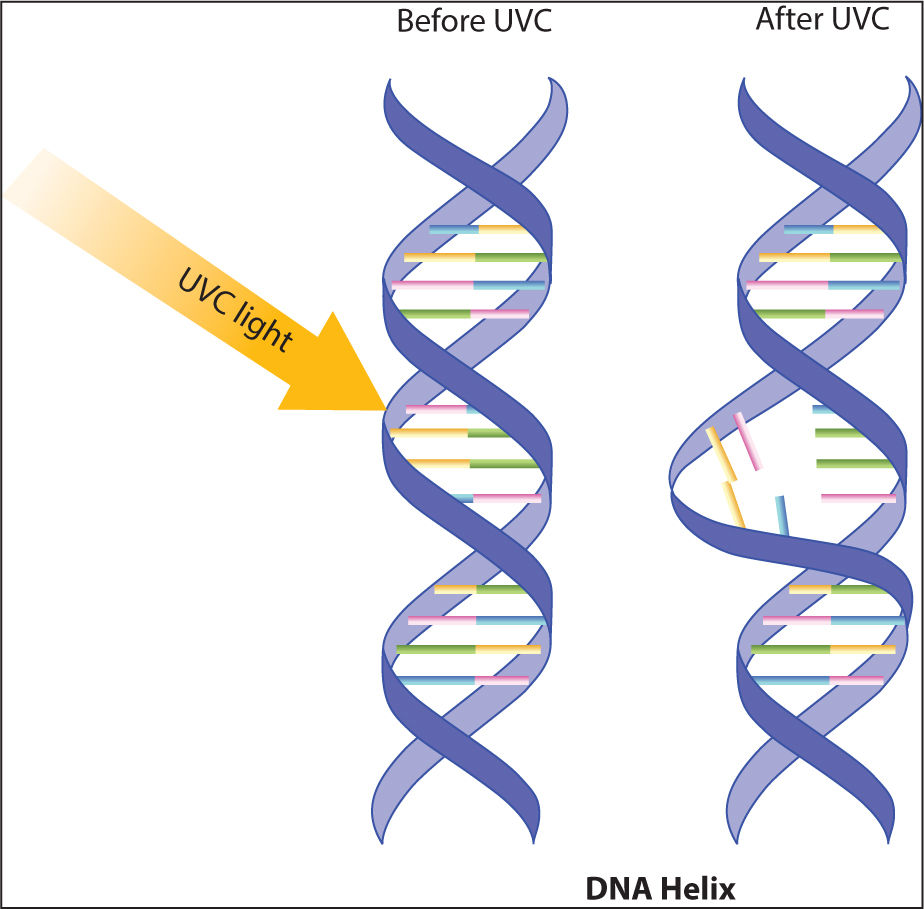
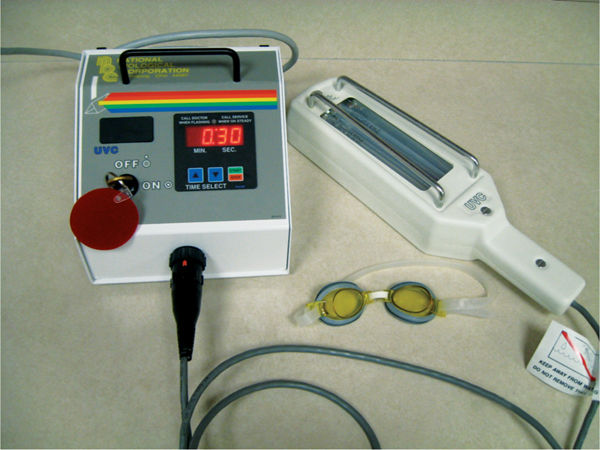
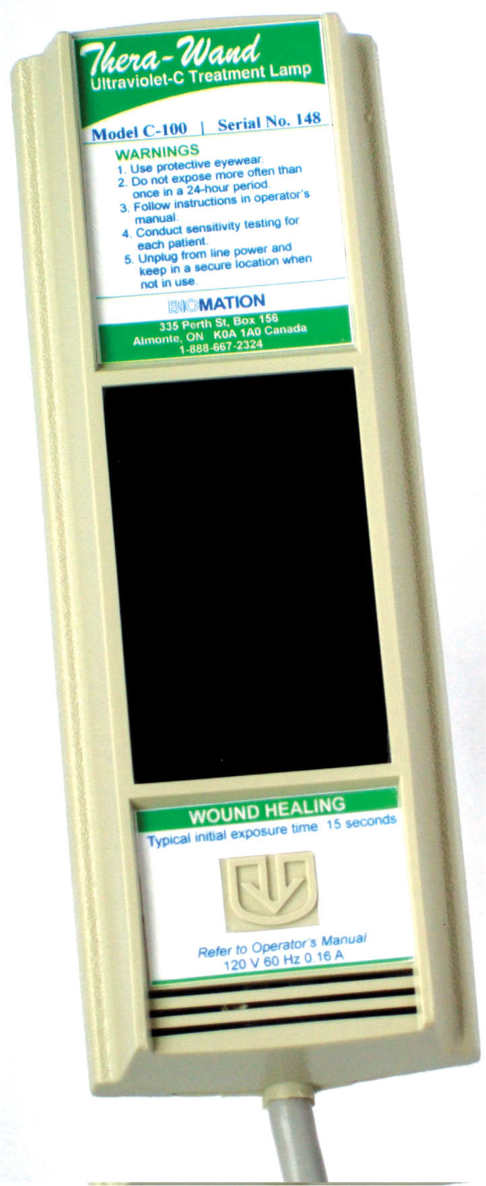
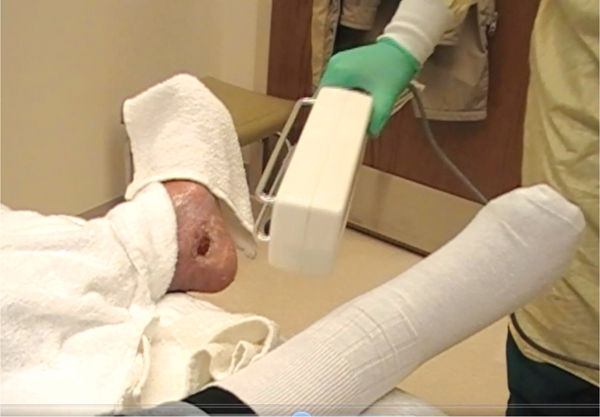
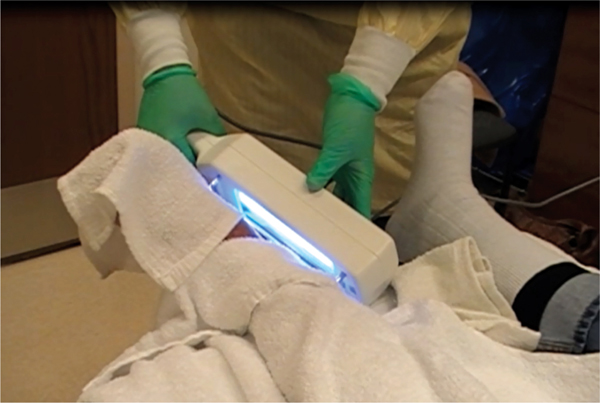
 Eye protection is required for both the clinician and the patient.
Eye protection is required for both the clinician and the patient. Skin surrounding the wound is completely protected using a UV blocking ointment and/or drape.
Skin surrounding the wound is completely protected using a UV blocking ointment and/or drape. UVC source is held parallel and 1 inch from the wound bed.
UVC source is held parallel and 1 inch from the wound bed. Only short treatment times of 30-60 seconds are needed to kill bacteria; do not treat more than 180 seconds.
Only short treatment times of 30-60 seconds are needed to kill bacteria; do not treat more than 180 seconds. Treatment is terminated immediately if the patient experiences an adverse reaction.
Treatment is terminated immediately if the patient experiences an adverse reaction.






